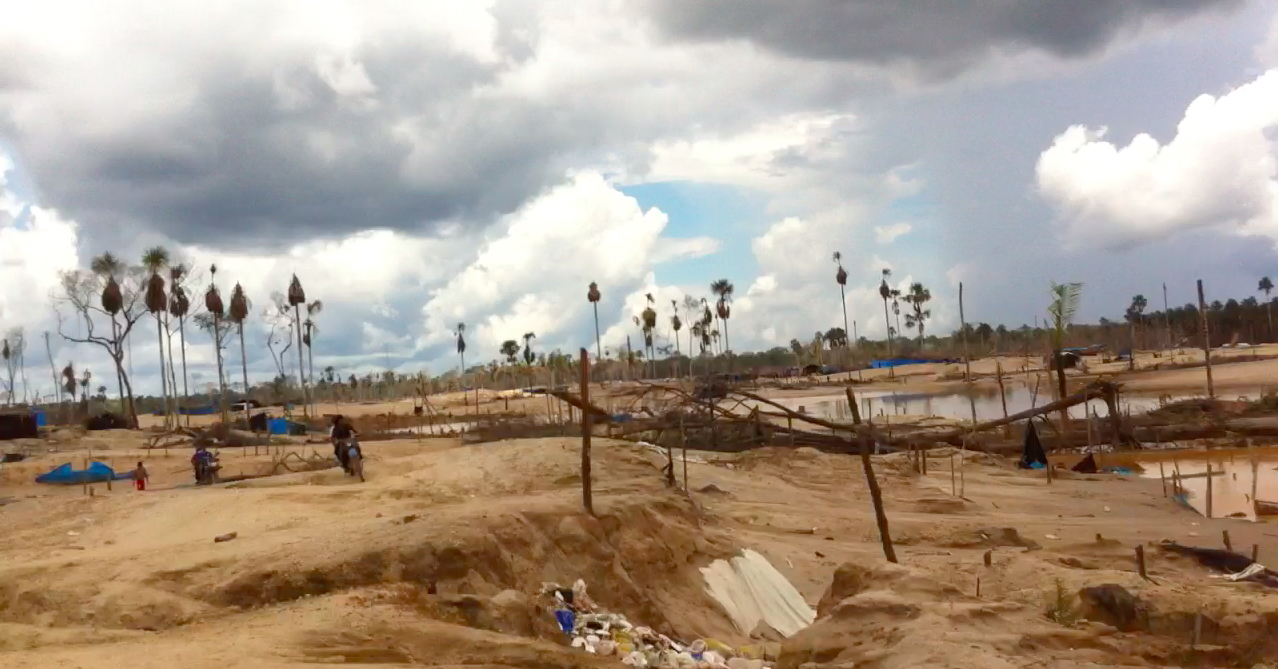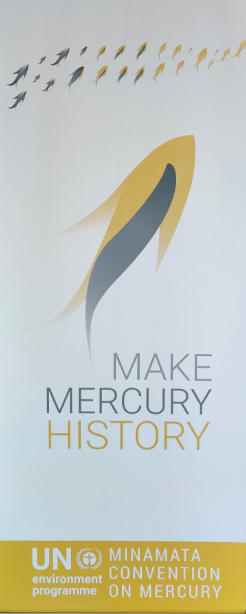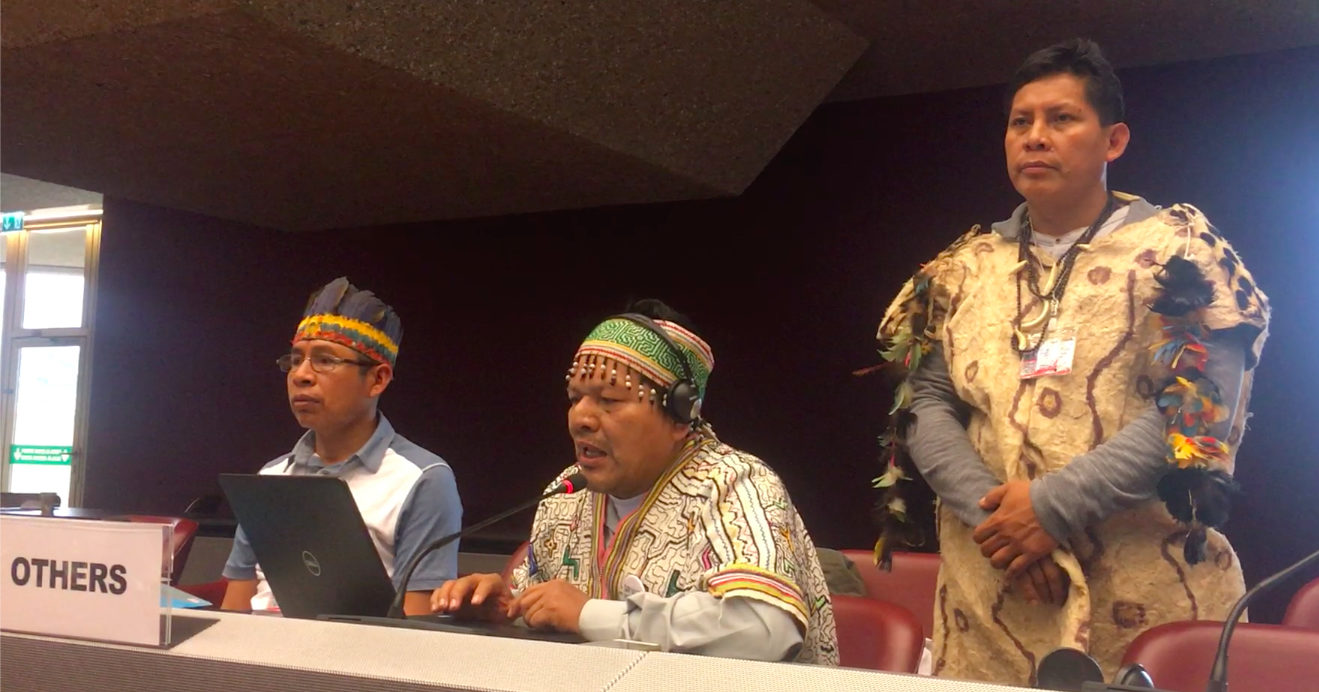Article begins
In Peru’s gold-rich Amazonian region of Madre de Dios (the Mother of God), the global demand for the precious metal has incentivized migration from the Andes to the Amazon. Facilitating this rainforest gold rush is the construction of the Interoceanic Highway across the South American continent. The illegal mining industry’s reliance on quicksilver (liquid mercury) means that the toxic heavy metal enters Amazonian waterways, soil, and air, contributing to a toxic load called a body burden. According to a leaked report, indigenous Amazonian communities—not just downstream, but also upstream from mining operations—show high levels of contamination.
After seeing the effects of mercury’s toxic touch on human and nonhuman health, I proposed a collaborative research design project with Amazonian indigenous communities, Andean gold miners, and sex workers. (As with many natural resource extraction projects, sex work becomes a companion industry.) As co-principal investigator on a Coupled Natural-Human Systems (CNHS) National Science Foundation grant (2019–2022), I was able to support indigenous Amazonian colleagues’ participation in Geneva.

Image description: A mostly barren, desert landscape is punctuated with a few trees.
Caption: Depiction of a mining site in Madre de Dios, where the decimation and pollution of mining is evident, 2012. Ruth Goldstein
During the final week of November 2019, the delegation from the Peruvian Amazon gathered in Switzerland. Two Indigenous representatives came from Madre de Dios: Julio Cusurichi, Shibipo president of the Native Federation of Madre de Dios (FENAMAD), and Luis Tayori, Harakbut leader of the Amarakaeri Communal Reserve (ECA-RCA). Richard Rubio, from Peru’s Kiwcha community and vice-president of the Pan-Amazonian Indigenous organization (AIDESEP) joined them. They were attending the third Conference of the Parties (COP3) to the Minamata Convention on Mercury, accompanied by two other anthropologists—in addition to myself—Daniel Rodriguez, advisor to FENAMAD, and Angela Arriola, advisor to AIDESEP.
I first met Cusurichi and Rodriguez in 2011 when I arrived in Peru’s southeastern Amazon from Brazil. I was not researching mercury toxicity at the time, but rather, the traffic in women, plants, and gold along the Interoceanic Highway. Today, Madre de Dios has an estimated 70,000 miners in the artisanal and small-scale gold mining (ASGM) industry, amalgamating quicksilver with gold particles. Excess liquid mercury is dumped onto the ground or into rivers. The fused mercury must be burned off to leave pure gold. Some 400 tons of the heavy metal is estimated to have entered Madre de Dios’s ecosystem.
The Minamata Convention marks the first global environmental agreement negotiated in the twenty-first century, with multipronged initiatives to “protect human health and the environment from anthropogenic emissions and releases of mercury and mercury compounds” (UNEP 2019, 9). In addition to ASGM, the global treaty recommends measures to eliminate mercury from cosmetics, light bulbs, batteries, pesticides, and dental amalgams.

Image description: A conference banner depicts the Minamata motto “Make Mercury History,” with a large stylized drawing of a gold and grey fish. Above the large fish are two rows of smaller fish, showing a progression from entirely grey fish to entirely gold fish.
Caption: Make Mercury History, Geneva, 2019. Ruth Goldstein
On the first day of the meeting, we paused in front of a conference banner. A goldfish swam above the Minamata motto: “Make Mercury History.” Booklets in multiple languages recounted the history of Japan’s Chisso Chemical Company, which leaked mercury into Minamata Bay between 1932 and 1968. First fish, then birds and cats, then humans became ill or died. Minamata disease entered medical dictionaries in 1956 as a “severe permanent neurologic disorder.”
The fourth day of the conference was Thanksgiving: Thursday, November 28. The holiday, as scholars including Philip Deloria note, is a feat of farcical state-crafting. The bloody settler-colonial histories that Thanksgiving disguises resonate with what Rob Nixon (2011) terms the “slow violence” that indigenous communities affected by mercury contamination continue to experience.
“Our people are sick like this, with the shaking … babies are dying,” Tayori murmured the day before Thanksgiving, during a meeting with Yuyun Ismawati. Ismawati, an Indonesian environmental engineer and 2009 Goldman Environmental Prize recipient, recently called for a global ban on ASGM, citing the irreversible damage that mercury has on human and nonhuman health. Ismawati showed images of children born with severe deformities: no mouth, no limbs, and missing organs. Andean miners have come to represent the contaminated and the contaminating in a social and ecological sense, yet they also experience health issues from mercury contamination.
Around the table, Rubio highlighted the introduction to the Convention’s text that specifically details the vulnerability of Indigenous communities to mercury, which bioaccumulates through fish, a staple food. He also noted that the guidance documents outlined the need for participation of key stakeholders in decision-making. The questions grew: “We are supposed to be part of this process. Aren’t we among the most impacted? Why haven’t we been consulted?”

Image description: The first Indigenous representatives to participate at the Minamata meetings are seated in a section called “Others.”
Caption: Making an intervention—Cusurichi (center), Rubio (left), and Tayori (right)—in Geneva, 2019. Ruth Goldstein
“Make Mercury History” is a double-entendre that carries its message best in English. On this “American” day of Thanksgiving, the three Indigenous leaders were indeed “making history” as the first Indigenous representatives to participate at the Minamata meetings (though we had to sit in the “Others” section, as depicted above). Cusurichi made an intervention during the plenary meeting, with Tayori and Rubio standing behind him in solidarity. He asked, on behalf of Indigenous peoples around the world, why they were not better represented at these meetings. He cited the high levels of mercury in river fish, the irrevocable damage to people’s health, and the Peruvian health ministry’s dismissal of hair samples, which are crucial for analyzing body burden levels. Later that day, the three leaders gave powerful presentations during the conference’s “Knowledge Labs,” which prompted the Peruvian delegation in Geneva to issue a statement saying, “ASGM is a complicated matter.”
Tayori, whose father is first-contacted Harakbut, underlined the need for education and collaboration, saying, “We don’t have a cosmology to explain mercury toxicity, the sickness and death it causes.” He described the history of Madre de Dios—the brutality of the rubber barons, enslavement of native tribes, and the runaways who comprise today’s “tribes living in voluntary isolation.” Native Amazonian communities often find themselves with the choice to leave their homes or join the extractive economy. The questions grew: “We are supposed to be part of this process. Aren’t we among the most impacted? Why haven’t we been consulted?”
Encultured racism in Peru (and throughout the Americas) translates into what amounts to “medical apartheid.” Here, the layers of Spanish colonialism are overlaid with Andean farmers migrating to the rainforest in search of a better life. Throughout the long colonial period and in the aftermath of the Civil War (1980–2000), many Peruvian politicians and the popular media cast Andeans as backward and dirty. And, much like Tayori’s Harakbut community, Andean gold miners do not typically fare well with health care workers. Meanwhile, “Operation Mercury,” a series of military raids to evict the miners, began in February 2019. Andean miners have come to represent the contaminated and the contaminating in a social and ecological sense, yet they also experience health issues from mercury contamination. These ASGM miners are vilified. Meanwhile, the majority of global consumers remain comfortably ignorant of where the gold in their electronics and jewelry originated.

Image description: The infographic title reads “Facts & Figures ASGM Artisanal and Small Scale Gold Mining” and overlays an image of a silver pan that someone is holding. Below that there is a line of human figures in blue, purple, and green; the text accompanying the figures reads “10–15 million miners including 4–6 million women and children.” The next line includes a stack of gold bars and text stating “12–15% of world gold supply.” Beside the gold bars is an illustration of a factory that is accompanied by the text “More than 1,400 tons of mercury per year released to the environment. Largest source of mercury pollution in the world. At the bottom of the infographic, there is a map of the world in grey with purple pins that represent the different areas affected. The clusters of pins are located in Africa, Southeast Asia, South America, and Central America. The text beside the map reads “over 70 countries affected.”
Caption: ASGM Facts and Figures. Global Mercury Partnership
Mercury’s ability to pass the blood-brain barrier and traverse amniotic fluid is a growing concern for Cusurichi, Tayori, Rubio, and their communities. The absence of protocols to monitor and address mercury contamination in mining areas generates further confusion and vulnerability. Mistrust in government-run clinics and hospitals among Amazonian and Andean Indigenous communities has grown since 2017, when the ministry of health abruptly eliminated its indigenous branch. FENAMAD and AIDESEP raised international attention, ultimately leading to the reinstatement of the Indigenous health division. Training for health care providers to diagnose mercury contamination remains inconsistent, however, as does informational health outreach.
As we sat down to dinner on that Thanksgiving evening, we discussed plans for the future and what it meant to “make mercury history.” Collaborative research design takes time. The global demand for gold adds another layer of complexity to tackling the health effects that stem from mercury’s toxic touch. Because mercury has no taste or smell in any of its forms, because it looks so lovely as liquid quicksilver, and because it can so effectively extract gold from the soil, it represents a particular health challenge. It is hard to believe mercury can be anything but magical. And yet, the stakes of a disappearing Amazonian rainforest are planetary.
Thank you, Cusurichi, Tayori, Rubio, Rodriguez, and Arriola for your continued efforts.
Ruth Goldstein is an assistant professor in the Women and Gender Studies Department at the University of Wisconsin, Madison. Her research examines the intersections of human and environmental health, with a focus on feminist technoscience, indigeneity, and critical race studies.
Please send your comments and ideas for SMA section news columns to contributing editors Dori Beeler ([email protected]) and Laura Meek ([email protected]).
Cite as: Goldstein, Ruth. 2020. “Mercury’s Toxic Touch.” Anthropology News website, October 2, 2020. DOI: 10.14506/AN.1514

